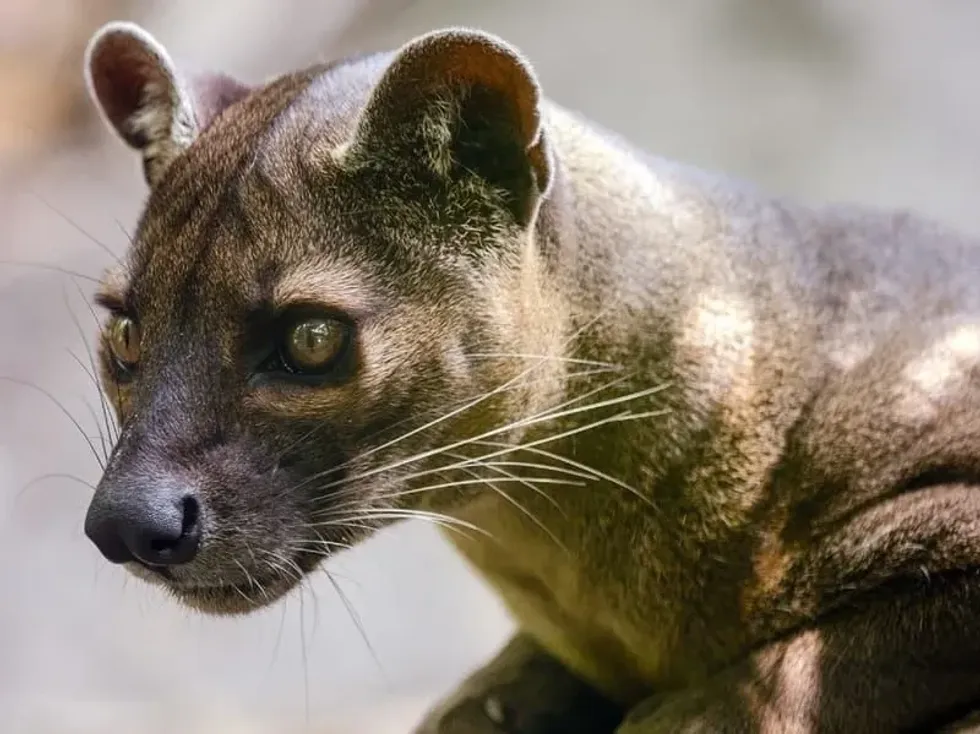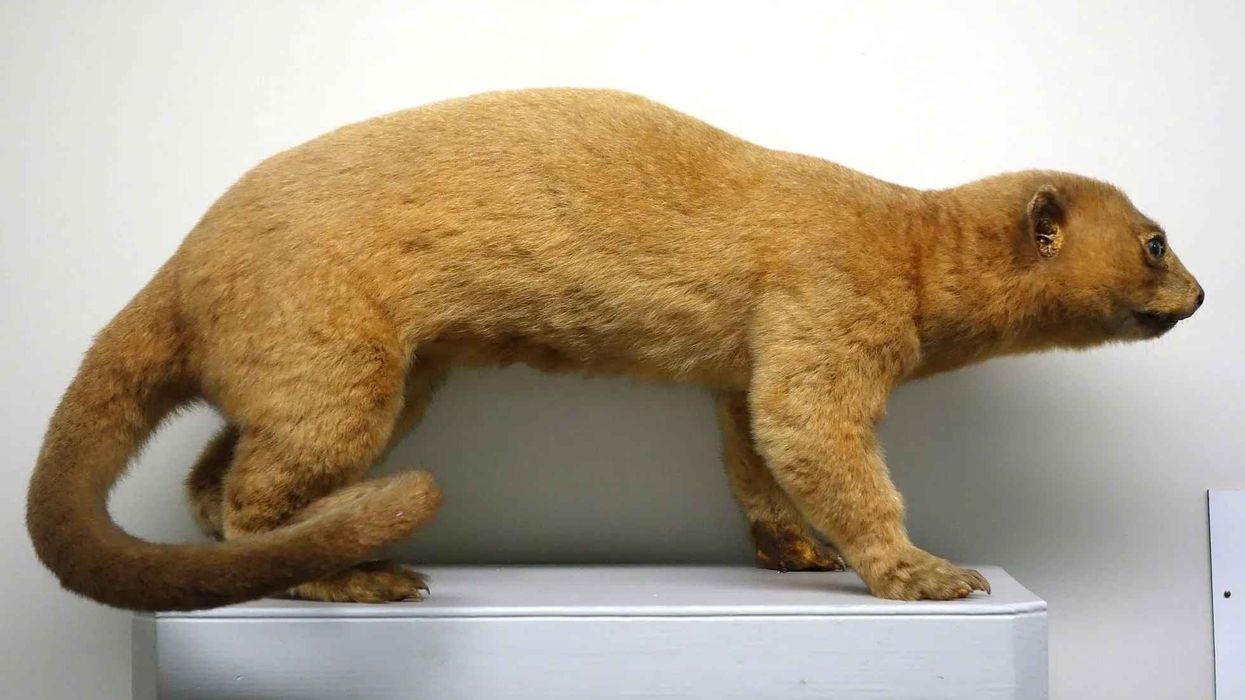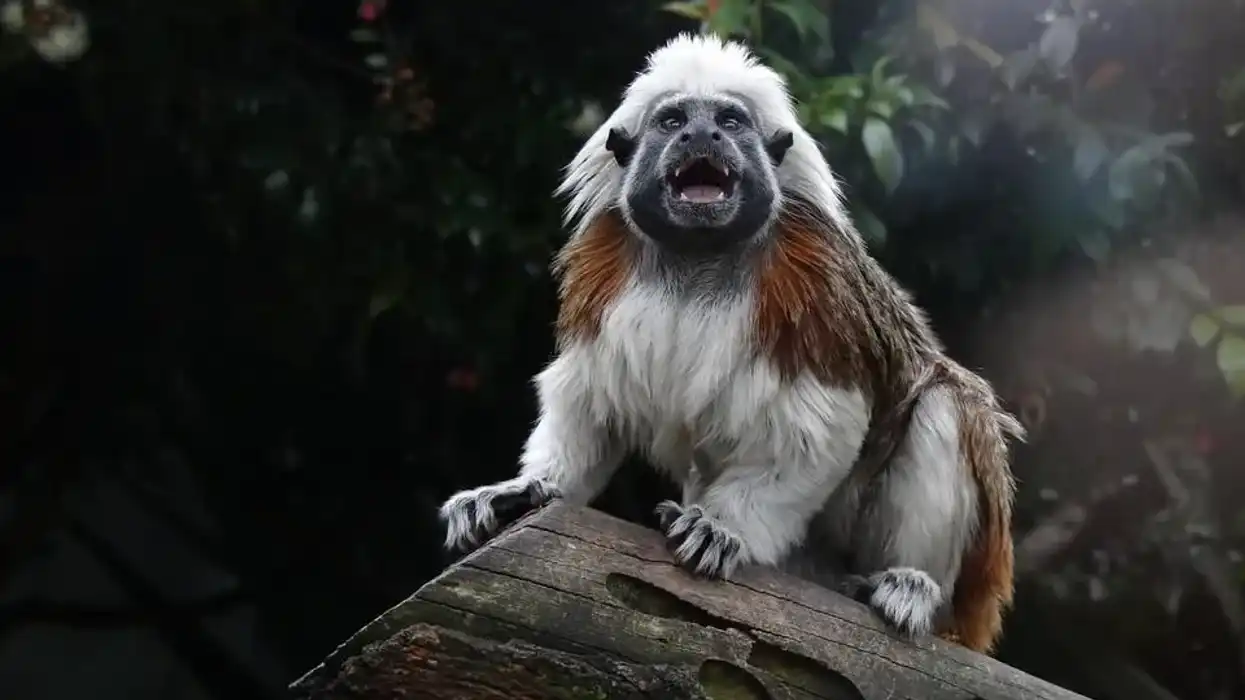Fun Kinkajou Facts For Kids

The kinkajou, or honey bear, is a tropical rainforest mammal from southern Mexico through Brazil belonging to the family Procyonidae linked to olingos, coatis, raccoons, and the ringtail and cacomistle. Indigenous to Central America and South America, this mammal is not an endangered species, though people rarely see it because it is active at nighttime.
This is the only member of the genus Potos and is also known as the honey bear. Kinkajous live on trees though they are not associated with any other tree-dwelling mammal group such as primates.
Since it resembles a monkey, kinkajous are falsely regarded as primates. Though they do hold some traits and peculiarities similar to primates.
Despite this, they are captured for their skins to create wallets and horse saddles, and for their meat. Their lifespan is expected to be 40 years in confinement.
Among other carnivores, binturongs and kinkajous are the only animals that possess a prehensile tail. This tail is used to provide grip on branches while doing other activities or for approaching food. While the normal litter size is one pup, sometimes female kinkajous give birth to one or two pups every breeding season.
Here are some interesting facts on kinkajou adaptations that will fascinate you. Afterward, do check our other articles on Pyrenean ibex facts and bharal facts.
Kinkajou Interesting Facts
What type of animal is a kinkajou?
The kinkajou comes under the kingdom Animalia. It belongs to the genus Potos from the family Procyonidae. While this animal does not feature in the list of endangered species, it is regularly targeted by poachers for their meat and fur.
What class of animal does a kinkajou belong to?
The kinkajou is listed under the class Mammalia, holding the biological name Potos flavus. There are scent glands on the throat, mouth, and belly on the body that allows kinkajous to mark their territory.
How many kinkajous are there in the world?
There is no proper data available regarding the global population. However, the reports say the proportion has been decreasing since 2016. The density estimate reveals that in Veracruz, Mexico, there are around 12 kinkajous per 0.62 sq. miles (1 sq. km), and in French Guiana, there are 20-30 kinkajous per 0.62 sq. miles (1 sq. km).
Where does a kinkajou live?
Kinkajous are rainforest mammals primarily found in closed-canopy forests, tropical forests, evergreen, savanna, and dry forests and live in different forest habitats. To avoid sunlight during the daytime, kinkajous sleep in shaded tangles of leaves or tree hollows.
What is a kinkajou's habitat?
A kinkajou's habitat comprises the Atlantic coastal evergreen gallery forests of the Cerrado in Brazil. They are spread in some forests of Central and South America as well. Reports say they are also present in the tropical perennial forests and some secondary forests in French Guiana.
Who do kinkajous live with?
Kinkajous are solitary animals meaning they enjoy their own company. It engages with others while eating fruits and also socializes. Sometimes, they all play together.
A normal kinkajou social set comprises two males, one female, and their young. If it is alone or traveling in a small bunch, kinkajous commonly cover the same path every night and manage to hold their region. Scent glands present at the edge of the mouth, the throat, and the belly aid kinkajous to mark their territory.
How long does a kinkajou live?
While captive, the kinkajou lifespan can extend up to 40 years. Nevertheless, the average kinkajou life span in confinement is estimated to be between 23-25 years.
How do they reproduce?
Males and females attain sexual development at the same age. The reproductive activity starts between the ages of one or two years.
Companions do not develop constant pair bonds, as a single male usually mates with multiple partners. Females happen to reproduce each year, and no appropriate seasonal order is witnessed. Females nurture infants until they mature and provide all care.
Hence, pregnant females are present in the group in all seasons. The gestation period is expected to be 98-120 days after which the female gives birth to one or two offsprings.
What is their conservation status?
As per the IUCN Status, this species is labeled as of Least Concern (2015 assessment) due to their widespread existence. They are also found to be docile to the point of habitat loss caused by the land conversion.
No data indicates any kind of population decline. However, in the future, if humans keep continuing to breach their habitat giving rise to habitat disruption and illegal hunting and animal acquisition for the pet trade, then we can foresee a significant population decline.
Kinkajou Fun Facts
What do kinkajous look like?

They possess small ears, large eyes, and webbed feet ending with tiny sharp claws. Their thick, fluffy fur serves as a raincoat to protect them and keep them dry. The kinkajou's tail is prehensile, usually longer than its body, and covered in lush fur.
How cute are they?
Yes, they are adorable. Kinkajous have large eyes that would make anyone awestruck. They have fluffy woolen fur, which makes them even cuter.
How do they communicate?
It is known to produce repeated 'weedle' vocalizations.
It also makes a variety of sounds, including chirping, hissing, screaming, etc. Often these sounds are made to notify someone if it is in danger or to warn the predator or enemy since these sounds are often made under threatening situations.
A kinkajou uses its scent to communicate and build courtship behavior with females. These scent glands found on the chest and belly region emit a predominantly pleasant, sweet smell.
Marking its scent is essential for physical, regional, and social interaction. Marking the tree branches using the throat, mandibular, and abdominal glands are its usual function. Kinkajous appear to depend on hearing and smell signs to interact with each other.
How big is a kinkajou?
The entire length of male kinkajou is 2.7-4.4 ft (0.82-1.34 m), and the female is 2.7-3.3 ft (0.82-1.00 m). Males are usually bigger than females.
They have an elongated body with a tail longer than their whole body. Since these are arboreal creatures, their tail is prehensile. The overall size of this wild animal is similar to that of a raccoon.
How fast can a kinkajou move?
Kinkajous can move very fast as they have the ability to rotate their feet in any direction. Those tiny feet are developed in such a way that aids them to move forward or backward to cling onto branches when they encounter any kind of intimidation.
In addition to that, they also possess a prehensile tail that has the potential to bear the entire body's body, enabling them to hold on to any branch while climbing trees.
How much does a kinkajou weigh?
Kinkajous weigh between 3.1-10.1 lb (1.40-4.62 kg). Male kinkajous are considerably bigger in size than females.
What are the male and female names of the species?
Both males and females of the species are called kinkajous holding the scientific name Potos flavus. There are no sex-specific names for them.
What would you call a baby kinkajou?
Baby kinkajous don't have a specific name.
What do they eat?
A kinkajou possesses razor-sharp teeth, but it principally dines on fruits, nectar, and honey in the forest trees. They also occasionally eat eggs, insects, frogs, and other plants.
These social animals play a vital role in dispersing seeds and are therefore called pollinators. Since they are sweet tooth creatures, the kinkajou's diet includes various tropical fruits, especially bananas, mangos, melons, grapes, pomegranates, and pineapples, including some seasonal vegetables.
During the nighttime, these nocturnal animals are overactive and engage in searching for food. They have a specifically developed extended long tongue to scoop out termite holes and extract honey from beehives.
Are they dangerous?
They are nocturnal and are used to living in a forest habitat. If a change of habitat happens or they experience an environmental shift, they may become aggressive or hostile. Hormones can trigger a kinkajou’s temperament giving rise to intrusive or unpredictable behavior in response to change in age, diet, small enclosure, lack of advancement, migration, etc.
Their bites can be pretty dreadful. Though they bite in defense, it can be excruciating.
Their bites are intense and can slice through skin, muscle, and bone. Most kinkajous lock your body part with their jaw like a clamp. They have canines similar to that of a cat and their claws are equally sharp.
Would they make a good pet?
Kinkajous are used to living in dense canopies in high trees. So you can imagine the kind of environment it needs. These hyperactive animals necessitate much space, which is not possible at home.
These nocturnal animals sleep throughout the day and are conscious all night. They are active at night, making all sorts of noise, which may interfere with owners' sleep schedules. They are attention seekers and may demand interaction all time.
They are socially good and bond only with fewer people. In case it notices any sort of disinterest from the owner, it may turn wild.
Kids and kinkajous don't gel well. Keep this in mind as both are active and unpredictable. Kinkajous may attack kids as they can't understand the kid's behavior.
Their bites are horrendous as they own very sharp teeth and pointed claws. Also, to have a kinkajou as a pet, you need a legal permit pet. Pet kinkajous are not allowed in many countries and communities.
Did you know...
Kinkajous can bark, shriek, hiss, and make high-pitched noises. This animal is also called 'la llorona' the 'crying woman' in Spanish, due to the strange noise it generates.
In Belize, kinkajous are described as nightwalkers.
Since the 1920s, San Diego Zoo Wildlife Alliance has been keeping kinkajous. Now, the San Diego Zoo and Safari Park both own a kinkajou. The kinkajou present in the zoo is an animal representative, meeting zoo guests up close during special programs as a symbol of vanishing rainforests.
Scent glands on the throat, mouth, and belly on the body allow kinkajous to mark their territory.
Potos flavus, the scientific name, which means golden drinker, possesses a golden-brown coat and relishes nectar. Kinkajous are commonly called the honey bear, as they attack beehives for the honey.
How do kinkajous protect themselves?
Their short, thick fur renders physical protection from bee stings. Their pointed paws have claws that support them to seek food. Kinkajous usually dangle by their tail while approaching for their food since they have a prehensile tail. They have razor-sharp teeth that help to clamp predators when they face a threat.
How is a kinkajou different from a monkey?
The kinkajou resembles monkeys as they both possess a prehensile tail and big protruding eyes but have a distinct teeth structure and dense fur on the bottoms of the feet. Other than the appearance, the kinkajou is not a monkey.
As monkeys come under primates, the kinkajou is likely associated with raccoons. This whole aspect where two groups develop resembling features is known as convergent evolution. Accordingly, here both kinkajous and monkeys own prehensile tails to survive in the higher canopies of tropical woods.
Here at Kidadl, we have carefully created lots of interesting family-friendly animal facts for everyone to discover! Learn more about some other mammals including tree pangolin facts or tenrec facts.
You can even occupy yourself at home by coloring in one of our free printable Kinkajou coloring pages.
We Want Your Photos!
More for You
See All
Bachelor of Science specializing in Mass Communication.

Adekunle Olanrewaju JasonBachelor of Science specializing in Mass Communication.
Bachelor of Arts specializing in Economics

Gowri RaoBachelor of Arts specializing in Economics
With a bachelor's degree in Economics from Krea University, Gowri is a highly skilled data analyst and an expert in regression and causation modeling. Her interests in economic trends, finance, and investment research complement her professional expertise. In addition to her professional pursuits, Gowri enjoys swimming, running, and playing the drums, and she is also a talented tutor.
Disclaimer
1) Kidadl is independent and to make our service free to you the reader we are supported by advertising. We hope you love our recommendations for products and services! What we suggest is selected independently by the Kidadl team. If you purchase using the Buy Now button we may earn a small commission. This does not influence our choices. Prices are correct and items are available at the time the article was published but we cannot guarantee that on the time of reading. Please note that Kidadl is a participant in the Amazon Services LLC Associates Program, an affiliate advertising program designed to provide a means for sites to earn advertising fees by advertising and linking to Amazon. We also link to other websites, but are not responsible for their content.
2) At Kidadl, we strive to recommend the very best activities and events. We will always aim to give you accurate information at the date of publication - however, information does change, so it’s important you do your own research, double-check and make the decision that is right for your family. We recognise that not all activities and ideas are appropriate for all children and families or in all circumstances. Our recommended activities are based on age but these are a guide. We recommend that these ideas are used as inspiration, that ideas are undertaken with appropriate adult supervision, and that each adult uses their own discretion and knowledge of their children to consider the safety and suitability. Kidadl cannot accept liability for the execution of these ideas, and parental supervision is advised at all times, as safety is paramount. Anyone using the information provided by Kidadl does so at their own risk and we can not accept liability if things go wrong.
3) Because we are an educational resource, we have quotes and facts about a range of historical and modern figures. We do not endorse the actions of or rhetoric of all the people included in these collections, but we think they are important for growing minds to learn about under the guidance of parents or guardians.







